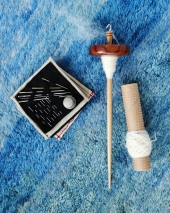What wheel do you use to spin on?
I finally bucked out and bought myself a new wheel this past summer- 30 years of on-again/off-again spinning- more "on" of late- I had to admit it was not just a passing phase and I deserved a pro wheel- I am SO thrilled with my majacraft suzypro!! My spinning has taken off like I could never have imagined as far as technique development goes...( I am NOT being paid to say that regardless how much I sound like an ad) my friend and spinning guru was always telling my yarn was under spun, I never seemed to be able to get enough twist in my wool or linen on my student level louet and did not have enough variables to work with in tension and yarn uptake.
I was lucky to have several friends with various wheels I could try before deciding what fit me best to invest in. What I liked about the suzypro was that the two treadle is responsive from both heel and toe- like riding a bike where your shoes click in so you have full power in complete rotation not just the forward motion.
When I sit down to spin i tend to be compulsive and be there for 4 or more hours, on my louet which was single treadle i kept throwing my hip out from my hips being off-kilter for so long. One of the two treadles I tried i could tell long term I would get shin splints from the constant toe work. What I like about the suzy pro is the wheel is very heavy and it requires very little foot energy- I can sit reclined in a chair "lazy boy style" and still spin! As a related note- i have a quirky spine, and cannot sit and work at a laptop on a desk without throwing my neck out and getting a migraine- i realized the same holds true for sitting looking down at the wheel for extended duration - so sitting low profile to spin ( also a good abdominal workout!) as a shift is good, and I have also trained myself to spin while watching subtitled shows on netflix- so I am forced to keep looking up away from my work! I wish I could say my language skills improved at the same time but alas not the case.

In my community of spinners we chatted about knee back and hip issues, and one of our solutions was to build a walking wheel- I commissioned Arlin ffrench to make one for us last summer that can be mounted in moments on the side of our shipping container storage bay in the park we work in. He made it from shipping skids, bike parts and the fly wheel is a skateboard wheel with a groove cut in it. the tension band is marine cable. it works like a dream and is great for teaching new spinners on as it is slower spinning to understand drafting. It also has a satisfying click click click sound that hearkens back to 70's gameshows of my childhood!
We just had the walking wheel complete in the fall and look forward to getting it going in a big way when the winter is over.
So far we are loving it and is a great hook to grab interest from those new to spinning and textile related skills.
my big spinning achievement last year was spinning kite line from our local linen for the kites we made from local plants ( plus hideglue from a local sheep). Nailing the Navajo 3 ply technique has rocked my fibregeek world! I have also just spun linen bowline for a local bow maker but haven't had a chance to get it to him yet- it was a 18 ply, singles line linen, 3 plied, then 3 plied again, then 2 plied.
Advice for anyone looking to buy a wheel: sample various types- dont just go by someone else's choice- and listen to your body for how it fits and feels for your feet, legs, hips, back and neck! If you plan to spin for long durations I would advise 2 treadle as more ergonomically balanced.
if you are curious about our kite making project, here is the short documentary we made.

 3
3












 3
3















 1
1




 2
2




















 2
2




.jpg)







 3
3




 2
2




 4
4























 1
1











 3
3

















